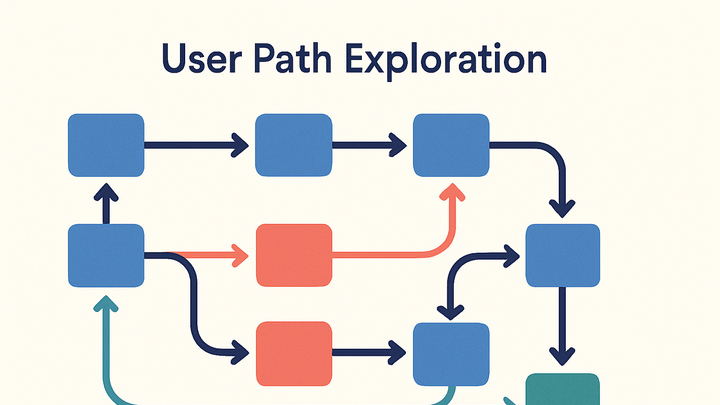Published on 2025-06-26T04:14:36Z
What is Path Exploration? Examples for Path Exploration
Path Exploration is an advanced analytical technique used to visualize and analyze the sequence of interactions users take on a digital property, such as a website or mobile app. It allows analysts to trace user journeys step by step, identifying common entry points, conversion routes, and drop-off moments. Unlike traditional funnel analysis, which relies on predefined steps, path exploration discovers all possible routes automatically, uncovering unexpected behaviors and opportunities for optimization. By mapping these paths, teams can pinpoint navigation bottlenecks, optimize content placement, and improve overall user experience. Tools like Google Analytics 4 (GA4) and PlainSignal (a cookie-free analytics solution) both offer path exploration capabilities, each with unique implementation approaches and privacy considerations.
Path exploration
Interactive analysis of user journeys through events or pages to identify conversion paths, drop-offs, and optimization insights.
Overview of Path Exploration
An introduction to the fundamentals of path exploration, its distinction from other journey analyses, and its role in modern analytics.
-
Definition
Path exploration is the process of visualizing sequences of user interactions (pages, events, actions) to see how users navigate through a digital property without predefining the steps.
-
Key components
Every path exploration view consists of nodes and edges that represent user interactions and transitions respectively.
-
Node
Represents a distinct event or page visit in the user journey.
-
Edge
Represents the transition or step taken by a user from one node to another.
-
How Path Exploration Works
Explains the mechanics behind building and interpreting path exploration reports.
-
Forward path analysis
Starts from a chosen event or page and moves forward, revealing the subsequent actions users take.
-
Backward path analysis
Begins with a target event (e.g., a purchase) and traces backward to see how users arrived there.
Key Benefits and Use Cases
Highlights practical applications of path exploration in optimizing digital experiences and business outcomes.
-
Conversion funnel optimization
Identify unexpected drop-off points and optimize pathways to increase conversion rates.
-
User behavior analysis
Discover common navigation patterns and tailor content layout to user preferences.
-
Content engagement
Understand how users flow between articles, videos, or features to boost engagement strategies.
Implementing Path Exploration in Analytics Platforms
Step-by-step examples of configuring path exploration in GA4 and PlainSignal.
-
GA4 implementation
- Navigate to the “Explore” section in GA4.
- Select the “Path exploration” template.
- Choose a starting or ending event (e.g., page_view, purchase).
- Configure dimension breakdowns, filters, and time frames.
- Analyze the generated node-edge graph to spot trends.
GA4 automatically tracks common events like
page_view, but you can send custom events via thegtag.jssnippet: -
PlainSignal integration
PlainSignal offers a simple, cookie-free path exploration setup. Add the snippet below to your HTML:
<link rel="preconnect" href="//eu.plainsignal.com/" crossorigin /> <script defer data-do="yourwebsitedomain.com" data-id="0GQV1xmtzQQ" data-api="//eu.plainsignal.com" src="//cdn.plainsignal.com/plainsignal-min.js"></script>Once installed, PlainSignal will begin capturing page views and custom events. In the PlainSignal dashboard, navigate to Insights → Path Exploration to visualize user flows.
Best Practices and Considerations
Guidelines to ensure accurate, privacy-compliant, and insightful path exploration analyses.
-
Data quality
Ensure consistent event naming conventions and reliable instrumentation to avoid fragmentation in paths.
-
Privacy compliance
Respect user consent and GDPR/CCPA regulations—PlainSignal’s cookie-free approach can help minimize compliance risk.
-
Analysis scope
Limit the depth of path steps to avoid overly complex graphs and focus on the most actionable segments.
